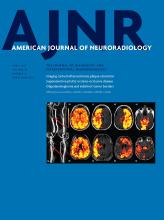Abstract
BACKGROUND AND PURPOSE: There are limited data on the use of postoperative imaging to evaluate the cordotomy lesion. We aimed to describe the cordotomy lesion by using postoperative MR imaging in patients after percutaneous cordotomy for intractable cancer pain.
MATERIALS AND METHODS: Postoperative MR imaging and clinical outcomes were prospectively obtained for 10 patients after percutaneous cordotomy for intractable cancer pain. Area, signal intensity, and location of the lesion were recorded. Clinical outcomes were measured by using the Visual Analog Scale and the Brief Pain Inventory–Short Form, and correlations with MR imaging metrics were evaluated.
RESULTS: Ten patients (5 men, 5 women; mean age, 58.5 ± 9.6 years) were included in this study. The cordotomy lesion was hyperintense with central hypointense foci on T2-weighted MR imaging, and it was centered in the anterolateral quadrant at the C1–C2 level. The mean percentage of total cord area lesioned was 24.9% ± 7.9%, and most lesions were centered in the dorsolateral region of the anterolateral quadrant (66% of the anterolateral quadrant). The number of pial penetrations correlated with the percentage of total cord area that was lesioned (r = 0.78; 95% CI, 0.44–0.89; P = .008) and the length of T2-weighted hyperintensity (r = 0.85; 95% CI, 0.54–0.89; P = .002). No significant correlations were found between early clinical outcomes and quantitative MR imaging metrics.
CONCLUSIONS: We describe qualitative and quantitative characteristics of a cordotomy lesion on early postoperative MR imaging. The size and length of the lesion on MR imaging correlate with the number of pial penetrations. Larger studies are needed to further investigate the clinical correlates of MR imaging metrics after percutaneous cordotomy.
ABBREVIATIONS:
- ALQ
- anterolateral quadrant
- PIS
- pain intensity score
- PSS
- pain severity score
- VAS
- Visual Analog Scale
- © 2017 by American Journal of Neuroradiology












